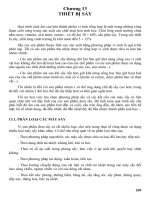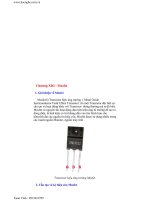20200202 sitrep 13 ncov v3
Bạn đang xem bản rút gọn của tài liệu. Xem và tải ngay bản đầy đủ của tài liệu tại đây (780.72 KB, 7 trang )
Novel Coronavirus(2019-nCoV)
Situation Report - 13
Data as reported by 2 February 2020*
HIGHLIGHTS
SITUATION IN NUMBERS
total and new cases in last 24
hours
•
No new countries have reported cases of 2019-nCoV acute respiratory disease in
the last 24 hours.
•
WHO is receiving information about cases from a number of countries. As
additional details become known, WHO requests countries to share information
in a timely manner as specified in the guidance on Global Surveillance for human
infection with novel coronavirus (2019-nCoV).
•
The first death has been reported outside of China, in the Philippines. The
patient was a close contact of the first patient confirmed in the Philippines.
•
Due to the high demand for timely and trustworthy information about 2019nCoV WHO technical risk communication and social media teams have been
working closely to track and respond to myths and rumours.
Globally
14557 confirmed (2604 new)
China
14411 confirmed (2590 new)
2110 severe (315 new)
304 deaths (45 new)
Outside of China
146 confirmed (14 new)
23 countries
1 death
WHO RISK ASSESSMENT
China
Regional Level
Global Level
Very High
High
High
Figure 1. Countries, territories or areas with reported confirmed cases of 2019-nCoV, 2 February 2020
*The situation report includes information reported to WHO Geneva by 10 AM
TECHNICAL FOCUS: Risk communication and community engagement
Managing the 2019-nCoV ‘infodemic’
The 2019-nCoV outbreak and response has been accompanied by a massive ‘infodemic’ - an over-abundance of
information – some accurate and some not – that makes it hard for people to find trustworthy sources and reliable
guidance when they need it.
Due to the high demand for timely and trustworthy information about 2019-nCoV, WHO technical risk
communication and social media teams have been working closely to track and respond to myths and rumours.
Through its headquarters in Geneva, its six regional offices and its partners, the Organization is working 24 hours a
day to identify the most prevalent rumours that can potentially harm the public’s health, such as false prevention
measures or cures. These myths are then refuted with evidence-based information. WHO is making public health
information and advice on the 2019-nCoV, including myth busters, available on its social media channels (including
Weibo, Twitter, Facebook, Instagram, LinkedIn, Pinterest) and website.
Country risk communication and community engagement (RCCE) preparedness and response
Country risk communication and community engagement (RCCE) is a critical public health intervention in all
countries. Countries should prepare to communicate rapidly, regularly and transparently with the population. All
countries should prepare existing public health communication networks, media and community engagement staff
to be ready for a possible case, and for the appropriate response if this happens. Countries should coordinate
communications with other response organizations and include the community in response operations. WHO stands
ready to coordinate with partners to support countries in their communication and community engagement
response.
Ensuring a people-centered response to 2019-nCoV
An expanding group of global response organization such as the United Nations Children’s Fund (UNICEF) and the
International Federation of Red Cross and Red Crescent Societies (IFRC) are coordinating efforts with WHO to ensure
that biomedical recommendations can be applied at the community level. These organizations are active at the
global, regional and country level to ensure that affected populations have a voice and are part of the response.
Ensuring that global recommendations and communication are tested, adapted and localized will help countries
better control the 2019-nCoV outbreak.
SURVEILLANCE
Table 1. Confirmed cases of 2019-nCoV acute respiratory disease reported by provinces, regions and cities in
China, 2 February 2020
Province/Region/City
Hubei
Zhejiang
Guangdong
Henan
Hunan
Anhui
Jiangxi
Chongqing
Sichuan
Jiangsu
Shandong
Beijing
Shanghai
Fujian
Shaanxi
Guangxi
Hebei
Yunnan
Heilongjiang
Liaoning
Hainan
Shanxi
Gansu
Tianjin
Guizhou
Ningxia
Inner Mongolia
Xinjiang
Jilin
Hong Kong SAR
Taipei
Qinghai
Macau SAR
Xizang
Total
Confirmed Cases
9074
661
604
493
463
340
333
262
236
231
225
183
177
159
116
111
104
99
95
64
63
56
45
40
38
28
26
23
21
14
10
9
7
1
14411
Table 2. Countries, territories or areas with reported confirmed cases of 2019-nCoV. Data as of 2 February 2020
WHO Regional Office
Country/Territory/Area
Confirmed Cases
China*
14411
Japan
20
Republic of Korea
15
Viet Nam
7
Singapore
18
Australia
12
Malaysia
8
Cambodia
1
Philippines
2
Thailand
19
Nepal
1
Sri Lanka
1
India
2
United States of America
8
Canada
4
France
6
Finland
1
Germany
8
Italy
2
Russian Federation
2
Spain
1
Sweden
1
United Kingdom
2
Eastern Mediterranean
United Arab Emirates
5
Total Confirmed cases
Total
Western Pacific
South-East Asia
Region of the Americas
European Region
14557
*Confirmed cases in China include cases confirmed in Hong Kong SAR (14 confirmed cases), Macau SAR (7 confirmed cases) and Taipei (10
confirmed cases).
Note: Case classifications are based on WHO case definitions for 2019-nCoV.
Figure 2: Epidemic curve of 2019-nCoV cases (n=76) identified outside of China, by date of onset of symptoms and
travel history, 2 February 2020
Note for figure 2: Of the 146 cases reported outside China, 11 were detected while asymptomatic. For the remaining
135 cases, information on date of onset is available only for the 76 cases presented in the epidemiologic curve.
Figure 3: Epidemic curve of 2019-nCoV cases (n=146) identified outside of China, by date of reporting and travel
history, 2 February 2020
STRATEGIC OBJECTIVES
WHO’s strategic objectives for this response are to:
•
•
•
•
•
•
Limit human-to-human transmission including reducing secondary infections among close contacts and
health care workers, preventing transmission amplification events, and preventing further international
spread from China*;
Identify, isolate and care for patients early, including providing optimized care for infected patients;
Identify and reduce transmission from the animal source;
Address crucial unknowns regarding clinical severity, extent of transmission and infection, treatment
options, and accelerate the development of diagnostics, therapeutics and vaccines;
Communicate critical risk and event information to all communities and counter misinformation;
Minimize social and economic impact through multisectoral partnerships.
*This can be achieved through a combination of public health measures, such as rapid identification, diagnosis
and management of the cases, identification and follow up of the contacts, infection prevention and control in
healthcare settings, implementation of health measures for travellers, awareness- raising in the population and
risk communication.
PREPAREDNESS AND RESPONSE
•
•
•
•
•
•
•
•
•
WHO has developed a protocol for the investigation of early cases (the “First Few X (FFX) Cases and contact
investigation protocol for 2019-novel coronavirus (2019-nCoV) infection”). The protocol is designed to gain an
early understanding of the key clinical, epidemiological and virological characteristics of the first cases of 2019nCoV infection detected in any individual country, to inform the development and updating of public health
guidance to manage cases and reduce potential spread and impact of infection.
WHO has been in regular and direct contact with Member States where cases have been reported. WHO is also
informing other countries about the situation and providing support as requested.
WHO has developed interim guidance for laboratory diagnosis, advice on the use of masks during home care and
in health care settings in the context of the novel coronavirus (2019-nCoV) outbreak, clinical management,
infection prevention and control in health care settings, home care for patients with suspected novel
coronavirus, risk communication and community engagement and Global Surveillance for human infection with
novel coronavirus (2019-nCoV).
WHO has prepared disease commodity package that includes an essential list of biomedical equipment,
medicines and supplies necessary to care for patients with 2019-nCoV.
WHO has provided recommendations to reduce risk of transmission from animals to humans.
WHO has published an updated advice for international traffic in relation to the outbreak of the novel
coronavirus 2019-nCoV.
WHO has activated of R&D blueprint to accelerate diagnostics, vaccines, and therapeutics.
WHO has developed an online course to provide general introduction to emerging respiratory viruses, including
novel coronaviruses.
WHO is providing guidance on early investigations, which are critical to carry out early in an outbreak of a new
virus. The data collected from the protocols can be used to refine recommendations for surveillance and case
definitions, to characterize the key epidemiological transmission features of 2019-nCoV, help understand spread,
severity, spectrum of disease, impact on the community and to inform operational models for implementation of
countermeasures such as case isolation, contact tracing and isolation. Several protocols are available here:
/>
•
•
WHO is working with its networks of researchers and other experts to coordinate global work on surveillance,
epidemiology, modelling, diagnostics, clinical care and treatment, and other ways to identify, manage the
disease and limit onward transmission. WHO has issued interim guidance for countries, which are updated
regularly.
WHO is working with global expert networks and partnerships for laboratory, infection prevention and control,
clinical management and mathematical modelling.
RECOMMENDATIONS AND ADVICE FOR THE PUBLIC
During previous outbreaks due to other coronavirus (Middle-East Respiratory Syndrome (MERS) and Severe
Acute Respiratory Syndrome (SARS), human-to-human transmission occurred through droplets, contact and
fomites, suggesting that the transmission mode of the 2019-nCoV can be similar. The basic principles to reduce
the general risk of transmission of acute respiratory infections include the following:
•
•
•
•
•
Avoiding close contact with people suffering from acute respiratory infections.
Frequent hand-washing, especially after direct contact with ill people or their environment.
Avoiding unprotected contact with farm or wild animals.
People with symptoms of acute respiratory infection should practice cough etiquette (maintain distance, cover
coughs and sneezes with disposable tissues or clothing, and wash hands).
Within healthcare facilities, enhance standard infection prevention and control practices in hospitals, especially in
emergency departments.
WHO does not recommend any specific health measures for travellers. In case of symptoms suggestive of respiratory
illness either during or after travel, travellers are encouraged to seek medical attention and share their travel history
with their healthcare provider.









